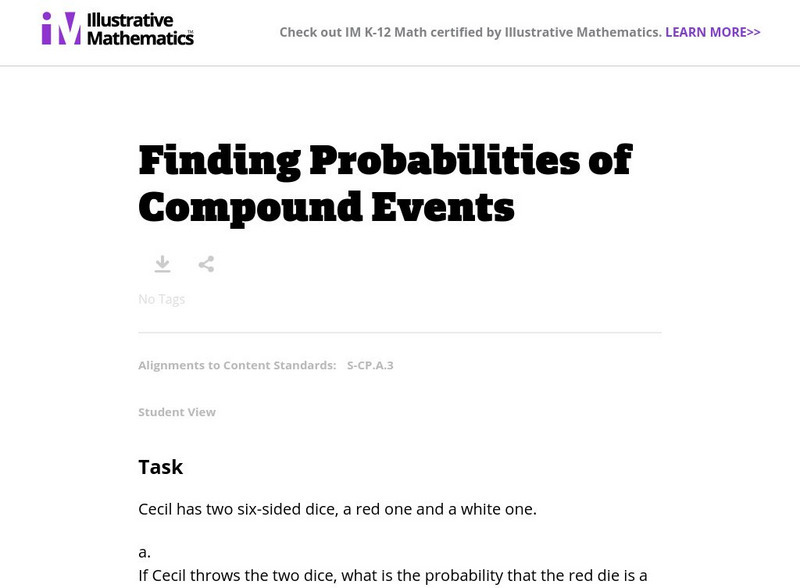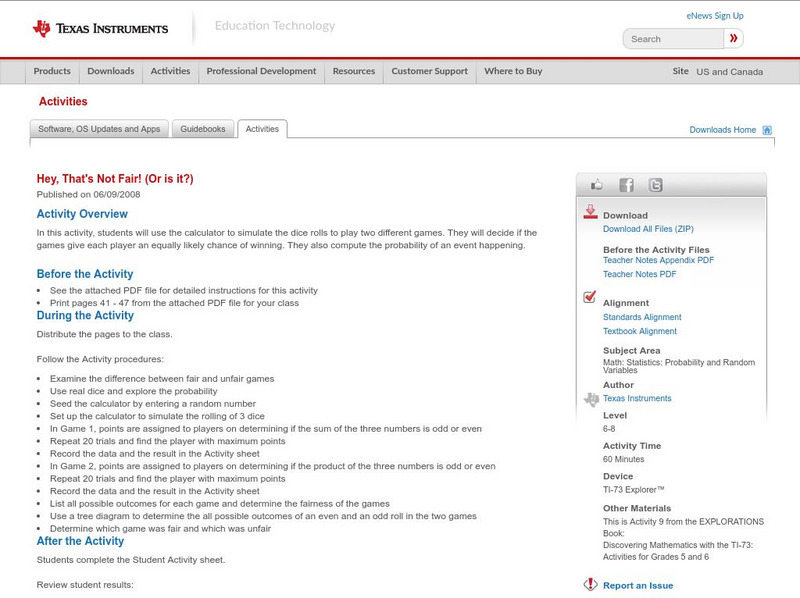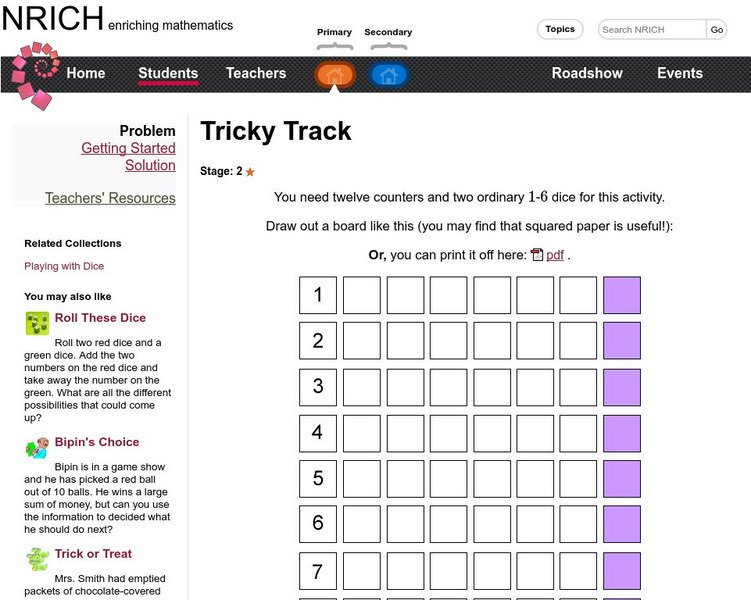Hi, what do you want to do?
Curated OER
The Fair Factor
Students participate in playing many games to determine if they are fair or not. They create their own game that is fair to play with their classmates.
Curated OER
Dominoes
Fourth graders solve a dominoes word problem, calculating all the possible outcomes for a sequence of events. They discuss the problem, apply counting strategies, create a tree diagram, and write an explanation of how they solved the...
Curated OER
Rules of Sign Change
Young scholars manipulate negative and positive numbers. In this integers lesson, students move through three activities exploring negative and positive whole numbers. A number line, cardboard function representation, and solving...
Curated OER
Mirror Writing
In this mirror writing instructional activity, students follow the directions to decide which alphabet letters are symmetrical. Students use a mirror and a white light as they work in partners to trace simple shapes.
Curated OER
Phone Button Boggle
For this phone button boggle worksheet, students identify the number of math words they can find on a phone keypad according to given directions. This one-page worksheet contains one problem. Answers are provided.
Curated OER
Niels Bohr
For this online interactive history worksheet, students respond to 9 short answer and essay questions about the achievements of Niels Bohr. Students may check some of their answers on the interactive worksheet.
Curated OER
Statistics and Probility
Seventh graders collect data and make predictions. In this geometry lesson, 7th graders work in tiers collecting data and plotting it. They make inferences and predictions about their collected data.
Curated OER
What's Ponytail's Big News?
Students discuss reasons to not smoke. In this anti-smoking lesson plan, students listen to a story where the character Ponytail the pony doesn't smoke and is thus able to engage in physical activities. They create Ponytail's pinwheel...
Shodor Education Foundation
Shodor Interactivate: Racing Game With Two Dice
Simulate a game where "N" players roll two dice, and the lucky player has an advantage for reaching the finish.
Illustrative Mathematics
Illustrative Mathematics: 7.sp Rolling Dice
Roll two dice 10 times. After each roll, note whether any sixes were observed and record your results in the table below. Aligns with 7.SP.C.7.
TED Talks
Ted: Ted Ed: The Last Banana: A Thought Experiment in Probability
Imagine a game played with two players and two dice: if the biggest number rolled is one, two, three, or four, player 1 wins. If the biggest number rolled is five or six, player 2 wins. Who has the best probability of winning the game?...
Illustrative Mathematics
Illustrative Mathematics: 7.sp.8 Tetrahedral Dice
Many games use dice which are six-sided and fair (meaning each face on the die is equally likely to land face up). Many games also use the sum of two dice rolled at the same time to determine movement of game pieces. However, not all...
Shodor Education Foundation
Shodor Interactivate: Experimental Probability
Experiment with probability using a fixed size section spinner, a variable section spinner, two regular 6-sided dice or customized dice.
Illustrative Mathematics
Illustrative Mathematics: S cp.a.3: Finding Probabilities of Compound Events
Cecil has two six-sided dice, a red one and a white one. Aligns with S-CP.A.3.
CK-12 Foundation
Ck 12: Algebra Ii: 5.1 Sample Spaces and Probability
This section explores how to determine the sample space, or possible outcomes, for an event such as rolling dice. It also investigates how to determine the probability of different outcomes occurring for an activity such as flipping a...
SMART Technologies
Smart: Dice and Card Math Games
Kids love dice and playing with decks of cards. Leverage these two great (and inexpensive tools) to help students work on math facts, place value and more.
ClassFlow
Class Flow: Donkey Derby Handling Data
[Free Registration/Login Required] Can you list all probabilities when two dice are thrown? Run your own race here and see which donkey wins.
California State University
Cal State San Bernardino: Intro to Probability Models
The concept of random variables comes to life with this Applet used to roll one, two, six, or nine dice. The user selects the number of rolls to be completed, and the program quickly counts and graphs the results.
Texas Instruments
Texas Instruments: Hey, That's Not Fair! (Or Is It?)
In this activity, students can use the calculator to simulate the dice rolls to play two different games. They will decide if the games give each player an equally likely chance of winning. They also compute the probability of an event...
University of Cambridge
University of Cambridge: Nrich: Tricky Track Game
The directions on this site are for an interesting, two-player dice game named Tricky Track. Grab a partner and play. Do your results surprise you?



















